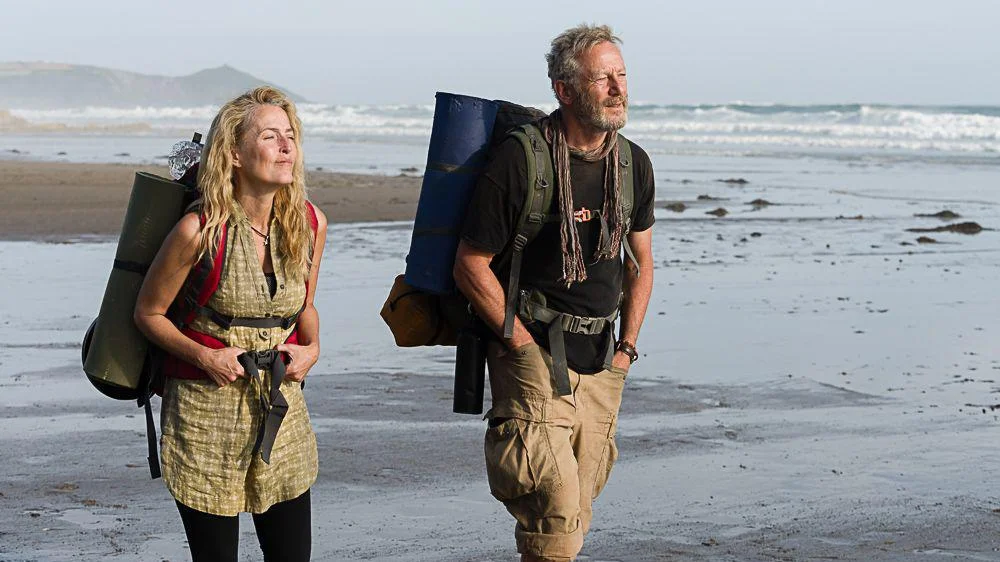
It’s rare these days that we are delivered a film that brings a resounding green light on the sanctity of marriage. Often, we are presented with messages of absolute failure (see Marriage Story and Scenes From A Marriage), or relationship narratives centered on hedonism or degenerate actions.
There’s a lot to say about The Salt Path, a film based on the true story memoir by Raynor Winn, but what is certain is that the core strength of the script derives from the notion of a compromising marriage that has had its paradise, but also had its Hell too, and shows no sign of giving up regardless-that’s resilience.
The film follows the real-life married couple of Raynor and Moth Winn, played by their counterparts Gillian Anderson (Scoop, Sex Education, The Pale Blue Eye) and Jason Isaacs (Operation Mincemeat, A Cure for Wellness). Raynor and Moth have lost their home after plunging into spiralling debt, and after a few missteps, find themselves in a blackhole that only means one thing: homelessness.

And so, the couple, primarily out of desperation over aspiration, decide to hike as far as possible along the Coastal Path of the UK to Land’s End, with barely a penny to their name, and suspect little amount of hiking and camping skills.
Director Marianne Elliott films The Salt Path incredibly naturally, to the point where at first I was concerned about the audio and the clarity of the dialogue. The couple haggled on the first route of their hike, and it took me a while to adjust my ears to what they were saying to each other.
But it makes sense of this entirely natural approach; the wind whistles, the rain pounds, and the atmosphere seeps in. The cruelty of nature is one of the delightful cornerstones of the film. My minor complaint was soon forgotten once I realized I could understand what was said.
If you’ve ever hiked–and when I say hike, I mean take on terrain worthy of calling it one–then The Salt Path will stand out to you as authentic. The film’s authenticity in portraying the challenges of the hike and the couple’s resilience is commendable. Compounding the experience is the degenerative disease that brings a disadvantage to the husband, Moth, who seemingly, and painfully, hobbles the coastal paths with his supportive wife.
The scenery itself is a character, showcasing the breathtaking world that the South West Coast Path of England has to offer in all its glory, whether in sunlight or rain. However, what I particularly enjoyed is how the experience of viewing beauty comes with utmost pain, as Anderson and Isaacs show the hardships of preparing a tent in high-speed winds.
The Salt Path highlights the resilience of a marriage, which I am glad it focused on. When the chips are down, it is easy to quit–the compelling experience in this story is how, despite how ugly the scenario is, the couple strives on, from a relatively middle-class life, to eating basic spaghetti in a tent. The message is clear from a thematic perspective; the ugly can be beautiful–the light at the end of the tunnel can be worth the Hell.
That’s not to say that the film promotes Hellish marriages that do not change course, and you should stay regardless–no. In the story, the couple shares concerns about their children as much as they do about their marriage. This aspect of the love for their children adds a layer of empathy to their journey. However, the story ties in quite superbly to this notion that love is more about action than words. Having this play out in unforgiving yet beautiful nature creates a double-edged narrative junction, where the final act becomes the truly emotionally resonant experience.
I’m sure the memoir-which I haven’t the fortune to read (and is on my book list), delves more into the logistics of the hike and the travels behind it, along with the frailties of being homeless, but I am grateful that the director let the camera do the talking rather than exhausting exposition, while the characters breathe into the more sentimental function of the story.
What Raynor and Moth Winn endured is nothing short of incredible, in so many ways that can be described, not just the physicality of it, and this film adaptation captures that essence.


